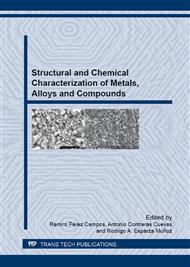p.1
p.9
p.15
p.21
p.29
p.39
p.47
p.53
Spectroscopy Study of Silver Nanoparticles Produced by Chemical Reduction
Abstract:
In this study, Ag nanoparticles were synthesized using two chemical reduction agents; ethylene glycol and sodium borohydride. Different particle size distributions were obtained and characterized by transmission electron microscopy. Ag nanoparticles concentrations of 1, 2 and 4 parts per million (gmL-1) were prepared and studied by ultraviolet-visible spectroscopy (UV-Vis) and atomic absorption spectrophotometry (AAS). In the UV-Vis results a characteristic band at 420 nm were observed. However, when the concentration of silver decreased, a change in band intensity was detected. Atomic absorption spectrophotometry measurements from different solutions of Ag nanoparticles showed a linear behavior similar to the silver standard solution in the concentration range 1 to 4 mgL-1. However, up 4 mgL-1 concentrations, the slope of the calibration curve is increases when the concentration of Ag nanoparticles is increased too.
Info:
Periodical:
Pages:
15-20
Citation:
Online since:
April 2013
Keywords:
Price:
Сopyright:
© 2013 Trans Tech Publications Ltd. All Rights Reserved
Share:
Citation:


